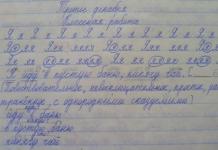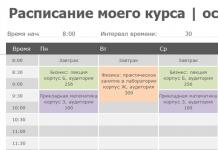1.2 Some important concepts and formulas from general astronomy
Before proceeding to the description of eclipsing variable stars, to which this work is devoted, we consider some basic concepts that we will need in what follows.
The star magnitude of a heavenly body is a measure of its brilliance accepted in astronomy. Glitter is the intensity of light reaching the observer or the illumination created at the radiation receiver (eye, photographic plate, photomultiplier, etc.). Glitter is inversely proportional to the square of the distance separating the source and the observer.
The magnitude m and brightness E are related by the formula:
In this formula, E i is the brightness of a star of m i -th magnitude, E k is the brightness of a star of m k -th magnitude. Using this formula, it is easy to see that the stars of the first magnitude (1 m) are brighter than the stars of the sixth magnitude (6 m), which are visible at the limit of visibility of the naked eye by exactly 100 times. It was this circumstance that formed the basis for constructing a scale of stellar magnitudes.
Taking the logarithm of formula (1) and taking into account that lg 2.512 = 0.4, we get:
 , (1.2)
, (1.2)
 (1.3)
(1.3)
The last formula shows that the magnitude difference is directly proportional to the logarithm of the magnitude ratio. The minus sign in this formula means that magnitude increases (decreases) with decreasing (increasing) brightness. The difference in stellar magnitudes can be expressed not only as an integer, but also as a fractional number. With the help of high-precision photoelectric photometers, it is possible to determine the difference in stellar magnitudes with an accuracy of 0.001 m. The accuracy of visual (eye) estimates of an experienced observer is about 0.05 m.
It should be noted that formula (3) allows one to calculate not stellar magnitudes, but their differences. To build a scale of stellar magnitudes, you need to choose some zero-point (reference point) of this scale. Approximately one can consider Vega (a Lyra) as such a zero-point, a star of zero magnitude. There are stars that have negative magnitudes. For example, Sirius (a Canis Major) is the brightest star in the earth's sky and has a magnitude of -1.46m.
The brilliance of a star, estimated by the eye, is called visual. It corresponds to a stellar magnitude, denoted by m u . or m visas. . The brilliance of stars, estimated by their image diameter and the degree of blackening on a photographic plate (photographic effect), is called photographic. It corresponds to the photographic magnitude m pg or m phot. The difference C \u003d m pg - m ph, depending on the color of the star, is called the color index.
There are several conventionally accepted systems of magnitudes, of which the systems of magnitudes U, B and V are most widely used. The letter U denotes ultraviolet magnitudes, B is blue (close to photographic), V is yellow (close to visual). Accordingly, two color indices are determined: U - B and B - V, which are equal to zero for pure white stars.
Theoretical information about eclipsing variable stars
2.1 History of discovery and classification of eclipsing variable stars
The first eclipsing variable star Algol (b Perseus) was discovered in 1669. Italian mathematician and astronomer Montanari. It was first explored at the end of the 18th century. English amateur astronomer John Goodryke. It turned out that the single star b Perseus, visible to the naked eye, is actually a multiple system that is not separated even with telescopic observations. Two of the stars included in the system revolve around a common center of mass in 2 days 20 hours and 49 minutes. At certain moments of time, one of the stars included in the system closes the other from the observer, which causes a temporary weakening of the total brightness of the system.
The Algol light curve shown in Fig. one

This graph is based on accurate photoelectric observations. Two brightness decreases are visible: a deep primary minimum - the main eclipse (the bright component is hidden behind the weaker one) and a slight decrease in brightness - the secondary minimum, when the brighter component outshines the weaker one.
These phenomena are repeated after 2.8674 days (or 2 days 20 hours 49 minutes).
It can be seen from the graph of brightness changes (Fig. 1) that immediately after reaching the main minimum (the lowest brightness value), Algol begins to rise. This means that a partial eclipse is taking place. In some cases, a total eclipse may also be observed, which is characterized by the persistence of the minimum value of the brightness of the variable in the main minimum for a certain period of time. For example, the eclipsing variable star U Cephei, which is accessible to observations with strong binoculars and amateur telescopes, has a total phase duration of about 6 hours at the main minimum.
By carefully examining the graph of changes in the brightness of Algol, you can find that between the main and secondary minima, the brightness of the star does not remain constant, as it might seem at first glance, but changes slightly. This phenomenon can be explained as follows. Outside of the eclipse, light from both components of the binary system reaches the Earth. But both components are close to each other. Therefore, a weaker component (often larger in size), illuminated by a bright component, scatters the radiation incident on it. Obviously, the greatest amount of scattered radiation will reach the Earth observer at the moment when the weak component is located behind the bright one, i.e. near the moment of the secondary minimum (theoretically, this should occur immediately at the moment of the secondary minimum, but the total brightness of the system decreases sharply due to the fact that one of the components is eclipsed).
This effect is called the re-emission effect. On the graph, it manifests itself as a gradual rise in the overall brightness of the system as it approaches the secondary minimum and a decrease in brightness, which is symmetrical to its increase relative to the secondary minimum.
In 1874 Goodryk discovered the second eclipsing variable star - b Lyra. It changes brightness relatively slowly with a period of 12 days 21 hours 56 minutes (12.914 days). In contrast to Algol, the light curve has a smoother shape. (Fig.2) This is due to the proximity of the components to each other.

The tidal forces that arise in the system cause both stars to stretch along a line connecting their centers. The components are no longer spherical, but ellipsoidal. During orbital motion, the disks of the components, which have an elliptical shape, smoothly change their area, which leads to a continuous change in the brightness of the system even outside the eclipse.
In 1903 the eclipsing variable W Ursa Major was discovered, in which the period of revolution is about 8 hours (0.3336834 days). During this time, two minima of equal or almost equal depth are observed (Fig. 3). A study of the star's light curve shows that the components are almost equal in size and almost touching surfaces.

In addition to stars like Algol, b Lyra and W Ursa Major, there are rarer objects that are also classified as eclipsing variable stars. These are ellipsoidal stars that rotate around an axis. A change in disk area causes slight changes shine.
Hydrogen, while stars with a temperature of about 6 thousand K. have lines of ionized calcium located on the border of the visible and ultraviolet parts of the spectrum. Note that this type of I has the spectrum of our Sun. The sequence of spectra of stars obtained by continuously changing the temperature of their surface layers is denoted by the following letters: O, B, A, F, G, K, M, from the hottest to ...





No lines will be observed (due to the weakness of the satellite spectrum), but the lines of the spectrum main star will fluctuate in the same way as in the first case. The periods of changes occurring in the spectra of spectroscopic binary stars, which are obviously also the periods of their rotation, are quite different. The shortest of the known periods is 2.4 hours (g of Ursa Minor), and the longest - tens of years. For...
Below is a list of useful words for astronomy. These terms were created by scientists to explain what happens in outer space.
It is useful to know these words, without understanding their definitions it is impossible to study the Universe and explain yourself on the topics of astronomy. I hope that the basic astronomical terms will remain in your memory.
Absolute value - How bright a star would be if it were 32.6 light-years from Earth.
Absolute zero - The lowest possible temperature, -273.16 degrees Celsius
Acceleration - Change in speed (speed or direction).
Skyglow - The natural glow of the night sky is due to reactions occurring in the upper layers of the Earth's atmosphere.
Albedo - The albedo of an object indicates how much light it reflects. An ideal reflector, such as a mirror, will have an albedo of 100. The moon has an albedo of 7, the earth has an albedo of 36.
Angstrom - A unit that is used to measure the wavelength of light and other electromagnetic radiation.
Annular - Having the shape of a ring or forming a ring.
Apoaster - When two stars revolve around each other, how far apart can they be (maximum distance between bodies).
Aphelion - During the orbital movement of an object around the Sun, when the most distant position from the Sun occurs.
Apogee - The position of an object in Earth's orbit when it is farthest from Earth.
Aerolite is a stone meteorite.
Asteroid - A solid body, or a small planet, revolving around the Sun.
Astrology - The belief that the position of the stars and planets affects the events of human destinies. This has no scientific justification.
Astronomical unit - Distance from the Earth to the Sun Usually written as AU.
Astrophysics - The use of physics and chemistry in the study of astronomy.
Atmosphere - The gaseous space surrounding a planet or other space object.
Atom - The smallest particle of any element.
Aurora ( northern Lights) - Beautiful lights over the polar regions, which are caused by the tension of the particles of the Sun when interacting with the Earth's magnetic field.
Axis - The imaginary line on which the object rotates.
Background radiation - Weak microwave radiation emanating from space in all directions. It is believed to be a remnant of the Big Bang.
Barycenter - The center of gravity of the Earth and the Moon.
Binary stars - A stellar duo that actually consists of two stars orbiting each other.
Black Hole - A region of space around a very small and very massive object in which the gravitational field is so strong that not even light can escape from it.
Bolide - A brilliant meteor that can explode during its descent through the Earth's atmosphere.
Bolometer - A detector sensitive to radiation.
Celestial Sphere - An imaginary sphere surrounding the Earth. The term is used to help astronomers explain where objects are in the sky.
Cepheids are variable stars that scientists use to determine how far away a galaxy is, or how far away a cluster of stars is from us.
Charge-Coupled Device (CCD) - A sensitive imaging device that replaces photography in most branches of astronomy.
Chromosphere - Part solar atmosphere, it is visible during a total solar eclipse.
Circumpolar Star - A star that never sets, it can be viewed all year round.
Clusters - A group of stars or a group of galaxies that are linked together by the forces of gravity.
Color Index - A measure of a star's color that tells scientists how hot the star's surface is.
Coma - A nebula surrounding the nucleus of a comet.
Comet - Small, frozen masses of dust and gas orbiting the Sun.
Conjunction - A phenomenon in which a planet approaches another planet or star, and moves between the other object and the body of the Earth.
Constellations - A group of stars that were given names by ancient astronomers.
Corona - The outer part of the Sun's atmosphere.
Coronagraph - A type of telescope designed to view the Corona Sun.
Cosmic rays - High-speed particles that reach the Earth from outer space.
Cosmology - The study of the universe.
Day - The amount of time it takes for the Earth to rotate around its axis.
Density - The compactness of matter.
Direct motion - Objects moving around the Sun in the same direction as the Earth - they move in a direct motion, unlike objects moving in the opposite direction - they move in a retrograde motion.
Diurnal motion - The apparent movement of the sky from East to West, caused by the Earth moving from West to East.
Ash light - A faint glow of the Moon over the dark side of the Earth. Light is caused by reflection from the Earth.
Eclipse - When we see an object in the sky blocked by the shadow of another object or the shadow of the Earth.
The ecliptic is the path of the sun, moon and planets that everyone follows in the sky.
Ecosphere - The area around a star where the temperature allows life to exist.
Electron - A negative particle that revolves around an atom.
Element - A substance that cannot be broken down further. There are 92 known elements.
The equinoxes are March 21st and September 22nd. Twice a year, when day and night are equal in time, around the world.
Second escape velocity - The speed required for an object to escape from the grip of another object's gravity.
Exosphere - The outer part of the Earth's atmosphere.
Flares - the effect of solar flares. Beautiful eruptions in the outer part of the Sun's atmosphere.
Galaxy - A group of stars, gas and dust that are held together by gravity.
Gamma - Extremely short-wavelength energetic electromagnetic radiation.
Geocentric - Simply means that the Earth is at the center. People used to believe that the universe is geocentric; The earth for them was the center of the universe.
Geophysics - Exploration of the Earth using physics.
HI region - Cloud of neutral hydrogen.
NI region - A cloud of ionized hydrogen (a region of the emission nebula of hot plasma).
Hertzsprung-Russell Diagram - A diagram that helps scientists understand the different types of stars.
Hubble constant - The ratio between the distance from an object and the speed at which it is moving away from us. Further, the object moves the faster, the further it becomes from us.
Planets that have an orbit less than the earth's - Mercury and Venus, which lie closer to the Sun than the Earth, are called the lower planets.
Ionosphere - The region of the Earth's atmosphere.
Kelvin - The measurement of temperature is often used in astronomy. 0 degrees Kelvin is equal to -273 degrees Celsius and -459.4 degrees Fahrenheit.
Kepler's Laws - 1. The planets move in elliptical orbits with the Sun at one of the foci. 2. An imaginary line connecting the center of the planet with the center of the Sun. 3. Time required for a planet to orbit around the Sun.
Kirkwood Gaps - Regions in the asteroid belt where there are almost no asteroids. This is due to the fact that the giant Jupiter changes the orbits of any object that enters these areas.
A light year is the distance traveled by a beam of light in one year. This is approximately 6,000,000,000,000 (9,660,000,000,000 km) miles.
Limb - The edge of any object in outer space. The Moon zone, for example.
Local Group - A group of two dozen galaxies. This is the group to which our galaxy belongs.
Lunation - The period between new moons. 29 days 12 hours 44 minutes.
Magnetosphere - The region around the object where the influence magnetic field object can be felt.
Mass - Not the same as weight, although the mass of an object helps determine how much it will weigh.
Meteor - A shooting star, these are dust particles entering the Earth's atmosphere.
Meteorite - An object from outer space, such as a rock, that falls to the Earth and lands on its surface.
Meteoroids - Any small object in outer space, such as clouds of dust or rocks.
Micrometeorite - Extremely small object. They are so small that when they enter the Earth's atmosphere, they do not create the effect of a star.
The Milky Way is our galaxy. (The word "Galaxy" actually means the Milky Way in Greek.)
Minor planet - Asteroid
Molecule - A group of atoms linked together.
Multiple Stars - A group of stars that revolve around each other.
Nadir - This is a point on the celestial sphere, directly below the observer.
Nebula - A cloud of gas and dust.
Neutrino - A very small particle that has no mass or charge.
Neutron Star - The remains of a dead star. They are incredibly compact and spin very fast, some spinning 100 times per second.
Novelty - A star that suddenly flashes before disappearing again - a flash many times stronger than its original brightness.
Terrestrial spheroid - A planet that is not perfectly round because it is wider in the middle, and shorter from top to bottom.
Eclipse - An occultation of one celestial body by another.
Opposition - When the planet is exactly opposite the Sun, so that the Earth is between them.
Orbit - The path of one object around another.
Ozone - An area in the Earth's upper atmosphere that absorbs many of the deadly radiations coming from space.
Parallax - The shift of an object when viewed from two different locations. For example, if you close one eye and look at your thumbnail and then switch eyes, you will see everything in the background shifting back and forth. Scientists use this to measure the distance to stars.
Parsec - 3.26 light years
Penumbra - The light part of the shadow is at the edge of the shadow.
Periastra - When two stars that revolve around each other are at their closest point.
Perigee - The point in an object's orbit around the Earth when it is closest to the Earth.
Perihelion - When an object that revolves around the sun is at its closest point to the sun
Disturbances - Disturbances in the orbit of a celestial object caused by gravitational attraction another object.
Phases - Obviously changing shape of the Moon, Mercury and Venus due to how much of the sun side is facing the Earth.
Photosphere - The bright surface of the Sun
Planet - An object that moves around a star.
Planetary nebula - A nebula of gas surrounding a star.

Precession - The Earth behaves like a top. Her poles spinning in circles cause the poles to point in different directions over time. It takes 25,800 years for the Earth to complete one precession.
Proper motion - The motion of stars across the sky as seen from Earth. Nearby stars have a higher proper motion than more distant ones, as in our car - it seems that closer objects such as road signs, moving faster than distant mountains and trees.
Proton - elementary particle at the center of the atom. Protons have a positive charge.
A quasar is a very distant and very bright object.
Shining - An area in the sky during a meteor shower.
Radio galaxies - Galaxies that are extremely powerful emitters of radio emission.
Redshift - As an object moves away from the Earth, the light from that object is stretched, making it appear redder.
Rotate - When something moves in a circle around another object, like the Moon around the Earth.
Rotation - When a rotating object has at least one fixed plane.
Saros (draconian period) - a time interval of 223 synodic months (approximately 6585.3211 days), after which the eclipses of the Moon and the Sun repeat in the usual manner. Saros cycle - Period of 18 years 11.3 days in which eclipses repeat.
Satellite - A small object in orbit. There are many electronic objects that revolve around the Earth.
Twinkling - Twinkling stars. Thanks to the Earth's atmosphere.
View - The state of the Earth's atmosphere at a particular point in time. If the sky is clear, astronomers say there is good viewing.
Selenography is the study of the surface of the moon.
Seyfert galaxies are galaxies with small bright centers. Many Seyfert galaxies are good sources of radio waves.
Shooting Star - Light into the atmosphere as a result of a meteorite falling to Earth.
Sidereal period — The period of time that an object in space takes to complete one full turn in relation to the stars.
Solar System - A system of planets and other objects orbiting the Sun.
Solar wind - A steady stream of particles from the Sun in all directions.
Solstice - June 22 and December 22. The time of year when the day is either shortest or longest, depending on where you are.
Spicules are the main elements, up to 16,000 kilometers in diameter, in the Sun's chromosphere.
Stratosphere - The level of the Earth's atmosphere is approximately 11-64 km above sea level.
Star - A self-luminous object that shines through the energy produced in nuclear reactions inside its core.
Supernova - A super bright explosion of a star. A supernova can produce the same amount of energy per second as an entire galaxy.
Sundial - An ancient instrument used to tell time.
Sunspots are dark spots on the surface of the Sun.
Outer Planets - Planets that lie farther from the Sun than the Earth.
Synchronous satellite - An artificial satellite that moves around the Earth at the same speed as the Earth rotates, so that it is always in the same part of the Earth.
Synodic period of revolution - The time it takes for an object in space to reappear at the same point in relation to two other objects, such as the Earth and the Sun
Syzygy - The position of the Moon in its orbit, in a new or full phase.
Terminator - The line between day and night on any celestial object.
Thermocouple - An instrument used to measure very small amounts of heat.
Time Slowdown - As you approach the speed of light, time slows down and mass increases (there is such a theory).
Trojan asteroids - Asteroids that revolve around the Sun, following the orbit of Jupiter.
Troposphere - The lower part of the Earth's atmosphere.
Shadow - The dark inner part of the sun's shadow.
Variable Stars - Stars that fluctuate in brightness.
Zenith - It's right above your head in the night sky.
1. The local time.
Time measured on a given geographic meridian is called local time this meridian. For all places on the same meridian, the hour angle of the vernal equinox (or the Sun, or the mean sun) at any given moment is the same. Therefore, on the entire geographic meridian, local time (stellar or solar) is the same at the same moment.
If the difference between the geographical longitudes of two places is D l, then in a more eastern place the hour angle of any star will be on D l greater than the hour angle of the same luminary in a more westerly location. Therefore, the difference of any local times on two meridians in the same physical moment is always equal to the difference between the longitudes of these meridians, expressed in hours (in units of time):
those. the local mean time of any point on earth is always equal to universal time at that moment plus the longitude of that point expressed in hours and considered positive east of Greenwich.
In astronomical calendars, the moments of most phenomena are indicated by universal time. T 0 . The moments of these events in local time T t. are easily determined by formula (1.28).
3. standard time. V Everyday life using both local mean solar time and universal time is inconvenient. The first because there are, in principle, as many local time counting systems as there are geographic meridians, i.e. countless. Therefore, in order to establish the sequence of events or phenomena noted in local time, it is absolutely necessary to know, in addition to the moments, also the difference in longitudes of the meridians on which these events or phenomena took place.
The sequence of events marked according to universal time is easily established, but the large difference between universal time and the local time of meridians, which are far from Greenwich Mean Time, creates inconvenience when using universal time in everyday life.
In 1884, it was proposed belt counting system of average time, the essence of which is as follows. Time is only kept on 24 major geographic meridians located from each other in longitude exactly 15 ° (or 1 h), approximately in the middle of each time zone. Time zones called the areas of the earth's surface into which it is conditionally divided by lines running from its north pole to the south and spaced approximately 7 °.5 from the main meridians. These lines, or boundaries of time zones, follow exactly the geographical meridians only in the open seas and oceans and in uninhabited places on land. For the rest of their length, they go along state, administrative, economic or geographical boundaries, retreating from the corresponding meridian in one direction or another. Time zones are numbered from 0 to 23. Greenwich is taken as the main meridian of the zero zone. The main meridian of the first time zone is located exactly 15 ° east of Greenwich, the second - 30 °, the third - 45 °, etc. until the 23 time zone, the main meridian of which has an east longitude from Greenwich 345 ° (or west longitude 15°).
Standard timeT p is called the local mean solar time, measured on the main meridian of a given time zone. It keeps track of time throughout the territory lying in a given time zone.
Standard time of this zone P is related to universal time by the obvious relationship
| T n = T 0 +n h . | (1.29) |
It is also quite obvious that the difference between the standard times of two points is an integer number of hours equal to the difference in the numbers of their time zones.
4. Summer time. In order to more rationally distribute electricity used for lighting enterprises and residential premises, and to make the most complete use of daylight in the summer months of the year, in many countries (including our republic), the hour hands of clocks running in standard time are moved forward by 1 hour or half an hour. The so-called summer time. In the fall, the clock is again set to standard time.
DST connection T l any point with its standard time T p and with universal time T 0 is given by the following relations:
 | (1.30) |
From the sea of information in which we are drowning, apart from self-destruction, there is another way out. Experts with a broad enough mind can create up-to-date summaries or summaries that briefly summarize key facts from a given area. We present an attempt by Sergei Popov to make such a code essential information in astrophysics.
S. Popov. Photo by I. Yarovaya
Contrary to popular belief, school teaching of astronomy was not up to par in the USSR either. Officially, the subject was in the curriculum, but in reality, astronomy was not taught in all schools. Often, even if the lessons were held, teachers used them for additional classes in their core subjects (mainly physics). And in very few cases, the teaching was of sufficient quality to have time to form an adequate picture of the world among schoolchildren. In addition, astrophysics is one of the most rapidly developing sciences throughout recent decades, i.e. the knowledge of astrophysics that adults received at school 30-40 years ago is significantly outdated. We add that now there is almost no astronomy in schools at all. As a result, for the most part, people have a rather vague idea of \u200b\u200bhow the world works on a scale larger than the orbits of the planets in the solar system.

Spiral galaxy NGC 4414

Cluster of galaxies in the constellation Coma Berenices

Planet around the star Fomalhaut
In such a situation, I think it would be wise to do a "Very short course in astronomy." That is, to highlight the key facts that form the foundations of the modern astronomical picture of the world. Of course, different specialists may choose slightly different sets of basic concepts and phenomena. But it's good if there are several good versions. It is important that everything can be stated in one lecture or fit into one small article. And then those who are interested will be able to expand and deepen their knowledge.
I set myself the task of making a set of the most important concepts and facts on astrophysics that would fit on one standard A4 page (about 3000 characters with spaces). At the same time, of course, it is assumed that a person knows that the Earth revolves around the Sun, understands why eclipses and the change of seasons occur. That is, absolutely “childish” facts are not included in the list.

Star forming region NGC 3603

Planetary nebula NGC 6543

Supernova remnant Cassiopeia A
Practice has shown that everything that is on the list can be stated in about an hour lecture (or in a couple of lessons at school, taking into account the answers to questions). Of course, in an hour and a half it is impossible to form a stable picture of the structure of the world. However, the first step must be taken, and here such a “study with large strokes” should help, in which all the main points that reveal the basic properties of the structure of the Universe are captured.
All images received space telescope"Hubble" and taken from the sites http://heritage.stsci.edu and http://hubble.nasa.gov
1. The Sun is an ordinary star (one of about 200-400 billion) on the outskirts of our Galaxy - a system of stars and their remnants, interstellar gas, dust and dark matter. The distances between stars in the galaxy are usually a few light years.
2. The solar system extends beyond the orbit of Pluto and ends where the Sun's gravitational influence compares to that of nearby stars.
3. Stars continue to form today from interstellar gas and dust. During their life and at the end of it, stars dump part of their matter, enriched with synthesized elements, into interstellar space. This is how the chemical composition of the universe changes today.
4. The sun is evolving. Its age is less than 5 billion years. In about 5 billion years, it will run out of hydrogen in its core. The Sun will become a red giant and then a white dwarf. Massive stars explode at the end of their lives, leaving a neutron star or black hole.
5. Our Galaxy is one of many such systems. There are about 100 billion large galaxies in the visible part of the universe. They are surrounded by small satellites. The galaxy is about 100,000 light years across. The nearest large galaxy is about 2.5 million light years away.
6. Planets exist not only around the Sun, but also around other stars, they are called exoplanets. Planetary systems are not alike. We now know over 1,000 exoplanets. Apparently, many stars have planets, but only a small part can be suitable for life.
7. The world as we know it has a finite age of just under 14 billion years. In the beginning, matter was in a very dense and hot state. Particles of ordinary matter (protons, neutrons, electrons) did not exist. The universe is expanding, evolving. In the course of expansion from a dense hot state, the universe cooled and became less dense, ordinary particles appeared. Then there were stars, galaxies.
8. Due to the finiteness of the speed of light and the finite age of the observable universe, only a finite region of space is available to us for observation, but the physical world does not end at this boundary. At great distances, due to the finiteness of the speed of light, we see objects as they were in the distant past.
9. Most of the chemical elements that we encounter in life (and of which we are made) originated in stars during their lives as a result of thermonuclear reactions, or in the last stages of the life of massive stars - in supernova explosions. Before the formation of stars, ordinary matter mainly existed in the form of hydrogen (the most common element) and helium.
10. Ordinary matter contributes only about a few percent to the total density of the universe. About a quarter of the density of the universe is associated with dark matter. It consists of particles that weakly interact with each other and with ordinary matter. So far, we are only observing the gravitational action of dark matter. About 70 percent of the density of the universe is associated with dark energy. Because of it, the expansion of the universe is going faster and faster. Nature dark energy unclear.
Crib
Astronomy and aviation
Answers to the test in astronomy. 1) Astronomy studies the movement of celestial bodies, their nature, origin. 2) The Universe is a part of the material world, which is available for research by astronomical means, corresponding to the achieved level of development ...
Answers to the test in astronomy.
1) Astronomy studiesmovement of celestial bodies, their nature, origin.
2) Universe - a part of the material world, which is available for research by astronomical means corresponding to the achieved level of development of science. It is also the entire existing material world, boundless in time and space and infinitely diverse in the forms that matter takes in the process of its development.
Universe - all that exists.
Universe - everything that we see with the help of instruments.
3) Formerly called constellationsflat part celestial sphere along which the stars are placed.
Now called constellationsa cone (not circular) that includes everything inside it.
4) At present, the entire sky is conditionally divided into 88 sections with strictly defined boundaries - constellations.
5) Constellations: Ursa Major and Minor, Cassiopeia, Lyra, Cygnus, Pegasus, Andromeda, Orion, Taurus, Charioteer, Gemini, Lesser and Greater Dog, Bolotlas, Virgo, Leo.
6) Celestial sphere is an imaginary sphere of arbitrarily large radius, in the center of which is the observer's eye.
7) How are star charts made?:
- the sphere is cut into thin strips, and then displayed on a plane.
- find the angle laid off from the vernal equinox, and connect it to the center of the universe.
9) Observable daily rotation of the celestial sphere(occurs from east to west) - an apparent phenomenon that reflects the actual rotation of the globe around its axis (from west to east).
11) World Axis - axis of rotation of the celestial sphere.
12) If through the North Star (the constellation Ursa Minor) to draw a line parallel to the axis of the Earth, then this will beearth's north pole.
13) true noon- the moment of the upper culmination of the center of the sun. The upper culmination is the highest height that is reached at the moment the luminary passes through the celestial meridian.
14) true solar day- the time interval between two successive climaxes of the same name of the center of the sun.
15) The length of a true solar day does not remain the same throughout the year (due to uneven movement Sun along the ecliptic and its inclination to the celestial equator). Therefore, in everyday life, not true, butmean solar day, whose duration is taken constant.
16) Universal Time is the mean time on the zero or Greenwich meridian.
17) World time is the time of its central meridian. Each time zone extends 15º or 1 hour in longitude (24 zones in total).
18) Standard time calculation:
T n \u003d T 0 +n; where T n - standard time; T 0 - universal time.
T n -T λ =n-λ; where T λ – local time; λ is geographic longitude.
19) On the territory of the Russian Federation since January 19, 1992, the following procedure for calculating time has been established: 1 hour is added to standard time; every year the clocks are moved forward 1 hour on the last Sunday in March at 2 am, and on the last Sunday in September (at 3 am) the clock hands are moved back 1 hour. Thus, summer time is 2 hours ahead of standard time. Summer time does not disturb the usual rhythm of life, but allows you to significantly save electricity spent on lighting.
20) Moscow time- local time in the capital of Russia, located in the second time zone. It is recommended as a common time for the Russian Federation.
21) Tropical year - the time interval between two successive passages of the Sun through the vernal equinox, which is 365 days 5 hours 48 minutes 46 seconds.
22) solar calendar- an account of long periods of time associated with the change of seasons of the year. Drawing up a calendar is difficult because the length of the tropical year is incommensurable with the length of the day.
23) in the julian calendar(old style, introduced in 46 BC by Julius Caesar) the average length of the year was 365.25 days: three years contained 365 days each, and a leap year - 366. This calendar is longer than the tropical one - for every 400 years the difference reaches 3 days .
The accumulated discrepancy was eliminated when in 1582 Pope Gregory the Thirteenth introduced a new style (Gregorian calendar). As a result of the reform, October 5, 1582 became October 15th. Years like 1700, 1800, 1900, 2000 were considered simple, not leap years. With the exception of years of this type, all others whose numbers are divisible by 4 are considered leap years. An error of one day accumulates in the Gregorian calendar (in which the length of the year is 365.2425 days) over 3300 years.
25) Stars - luminous gas (plasma) balls, similar to the sun. They are formed from a gas-dust environment (hydrogen and helium) as a result of gravitational condensation.
26) The difference between a star and a planetis that the planet (“wandering”) glows with reflected sunlight, and the star emits this light (a self-radiating stellar body).
27) In ancient astronomyThe world was divided into two parts: earthly and heavenly. They thought that there was a "firmament of heaven", to which the stars were attached, and the Earth was taken for the motionless center of the universe.
The idea of the central position of the Earth in the Universe was subsequently put forward by scientists Ancient Greece the basisgeocentric systems of the world. Aristotle (384-322 BC; Greek philosopher) noted that if the Earth moved, this movement could be detected by the change in the position of the stars in the sky. Claudius Ptolemy (2nd century BC; Alexandrian astronomer) developed the geocentric system of the world, according to which the Moon, Mercury, Venus, the Sun, Mars, Jupiter, Saturn and the “sphere of the fixed stars” move around the stationary Earth.
According to the teachings of Nicolaus Copernicus (1473-1543; Polish astronomer), the center of the world is not the Earth, but the Sun. Only the Moon moves around the Earth. The Earth revolves around the Sun and rotates around its own axis. At a very great distance from the Sun, Copernicus placed the "sphere of the fixed stars." This system was namedheliocentric.Giordano Bruno (1548-1600; Italian philosopher), developing the teachings of Copernicus, argued that there is no and cannot be a center in the Universe, that the Sun is only the center of the Solar System. He conjectured that the stars are the same suns as ours, and planets move around countless stars, many of which have intelligent life. In 1609, Galileo Galilei (1564-1642) first directed a telescope to the sky and made discoveries that clearly confirm the teachings of Copernicus: on the Moon he saw mountains, discovered four satellites of Jupiter, discovered the phases of Venus, discovered spots on the Sun, established that various celestial bodies axial rotation. Finally, he discovered that the Milky Way is a lot of faint stars that are not visible to the naked eye. Consequently, the Universe is much grander than previously thought, and it is naive to assume that it makes a complete revolution around the small Earth in a day. In Austria, Johannes Kepler (1571-1630) developed the teachings of Copernicus, discovering the laws of planetary motion. In England, Isaac Newton (1643-1727) published his famous law gravity. In Russia, the teachings of Copernicus were boldly supported by M.V. Lomonosov (1711-1765), who discovered the atmosphere on Venus, defended the idea of a plurality of inhabited worlds.
28) Nicholas Copernicus(1473 - 1543) lived in Poland. He proposed his own system of the world, according to which the center of the world is not the Earth, but the Sun. Only the Moon revolves around the Earth, and the Earth is the third planet from the Sun and revolves around it and its axis. The system he proposed is called heliocentric. But Copernicus not only gave the correct scheme for the structure of the solar system, but also determined the relative distances (in units of the distance of the Earth from the Sun) of the planets from the Sun and calculated the period of their revolution around it.
Galileo Galilei (1564 - 1642) Italian. Clearly confirmed the teachings of Copernicus. Having discovered mountains on the Moon, he established that the lunar surface is in many ways similar to the earth. He also discovered 4 moons of Jupiter; discovered that Venus, like the Moon, changes its phases (hence, it is a spherical body that shines with reflected sunlight); established that the Sun rotates around its axis, and also found spots on it. Finally, he discovered that Milky Way- this is a lot of faint stars that are not visible to the naked eye. These discoveries allowed him to confirm the teachings of Copernicus, as well as to assert that the Universe is much larger than previously thought.
Mikhail Vasilievich Lomonosov(1711 - 1765) - supported the teachings of Copernicus, discovered the atmosphere on Venus, defended the idea of a plurality of inhabited worlds.
Johannes Kepler - Austrian (1571 - 1630) discovered 3 basic laws of planetary motion:
- The orbit of each planet is an ellipse with the Sun at one of its foci.
- Radius - the vector of the planet in equal intervals of time describes equal areas.
- The squares of the sidereal periods of two planets are related as the cubes of the semi-major axes of their orbits.
29) Determining the distance to bodies and their dimensions.
To determine the distance to the bodies is usedparallax method: in order to find out the distance to any body, you need to measure the distance to any accessible point (it is called the basis and within the solar system the equatorial radius of the Earth is taken for it), the angle at which from a star on the horizon would be the basis is visible, is called the horizontal equatorial parallax, if it is found, then the distance is:
D = R / sinp
R - basis, p
radar methodconsists in the fact that a short-term impulse is sent to the luminary, the reflected signal is received and the time is measured. (1a.u.=149,597,868km).
Laser location methodsimilar to radar, but much more accurate.
Determining the size of the bodies of the solar systemcarried out by measuring the angle at which they are visible from the Earth and the distance to the luminaries, this is how the linear radius is obtained:
R = D * sin p
R - basis, p - horizontal parallax of the luminary
30) Kepler's laws:
1) The orbit of each planet is an ellipse, in one of the focuses of which is the Sun.
2) Radius - the vector of the planet in equal periods of time describes equal areas.
3) The squares of the sidereal periods of two planets are related as the cubes of the semi-major axes of their orbits.
31) Earth:
- Dimensions: Rav. = 6371km.
- Average density= 5.5*1000 kg/cu.m.
- Shape: ellipse, equatorial radius > polar radius.
- Tilt angle: 66 degrees 34 minutes.
- Features of the movement: the inclination of the earth's axis to the plane of the orbit. Preservation of the direction of the axis in space.
- Orbit: Elliptical around the Sun, close to a circle.
32 ) Solar and lunar eclipses:
When the Moon, during its movement around the Earth, completely or partially obscures the Sun,solar eclipses.
A total eclipse is possible because the apparent diameters of the Moon and the Sun are almost the same. Partial eclipses occur when the lunar disk does not completely obscure the disk of the Sun, as well as in areas of lunar penumbra.
When, when moving around the Earth, the Moon falls into the cone of the Earth's shadow,total lunar eclipse. If only a part of the moon is immersed in the shadow,partial lunar eclipse.
Eclipses are repeated at certain intervals, called saros (explained by patterns in the movement of the moon), it is approximately 18 years 11 days. During each saros there are 42 solar and 28 lunar. However, total solar eclipses at a given point on the earth's surface are observed no more than once every 200-300 years.
33) Moon:
- Dimensions: linear diameter is approximately equal to 3476 km.
- Age: approximately 4 billion years
- Structure: crust - 60 km, mantle -1000 km, core -750 km.
- Luminosity: non-self-luminous body, shines by reflected sunlight.
- Distance to Earth: 384,400 km.
- Surface features: during the lunar day, the temperature on the surface changes by about 300K,
- On the surface there are also seas (30%), continents (70%) and ring craters (diameter 1 - 200 km.)
- Mechanical properties soil: rocks similar to terrestrial basalts, refractory metals predominate, as well as Si, Fe, Cu, Mg, Al.
- Changing the surface over time: the era of active volcanism has long ended, the intensity of meteorite bombardment has decreased, although moonquakes still occur now. But in general, over the past 2-3 billion years, the surface has hardly changed.
- Features of the movement: The moon revolves around the Earth and its axis, as a result of which it is always turned to the Earth with one hemisphere.
- Comparison with the size of the Earth: 4 times less than the earth's radius and 81 times less than the mass.
- Double planet: the common center of mass of the Earth-Moon system, located inside the Earth, moves in an elliptical orbit around the Sun. Therefore, this system is often called a "double planet".
- Gravity on the Moon: 0.16 g.
34) Terrestrial planets:
Name |
Mercury |
Venus |
Land |
Mars |
Location |
0.39 a.u. from the sun |
0,72 |
1,52 |
|
|
Average density |
5.5*10000kg/cu.m. |
|||
|
Movement Features |
In the direction opposite to the direction of its movement around the Sun and about 243 times slower than the Earth |
Movement around the Sun and its axis, the inclination of the earth's axis to the plane of the orbit. Preservation of the direction of the axis in space. |
Movement around the Sun and its axis in one direction |
|
|
satellites |
Not |
No |
1 - Moon |
2 - Phobos, Deimos |
|
Tilt angle |
89 gr. |
86,6 |
66,5 |
65,5 |
|
Comparison of diameter with the earth |
Approximately 0.3 D of Earth |
Approximately 0.9 D of Earth |
Approximately 0.5 D of Earth |
|
|
The presence of a) atmosphere b) water c) life |
a) Traces b) no |
a) very dense |
a) thick b) in the form of surface waters, glaciers, groundwater |
a) sparse b) presumably in the form of glaciers |
|
Temperatures |
500K |
|||
|
Surface features |
The surface is similar to the moon, a large number of craters, there are also seas and extended mountain ledges |
The smoothest surface of all the terrestrial planets. Also the presence of craters, as well as large mountain ledges |
Presence of continents and oceans |
The presence of craters, seas, continents, as well as mountain gorges and canyons, large mountain cones |
35) Giant planets:
Name |
Jupiter |
Saturn |
Uranus |
Neptune |
Location |
5.20 a.u. from the sun |
9.54 |
19.19 |
30.07 |
|
Average density |
1.3*1000 kg/cu.m. m. |
|||
|
Movement Features |
Very fast rotation around the Sun and its axis in the same direction |
Very fast rotation around the Sun and its axis in different directions |
Very fast rotation around the Sun and its axis in the same direction |
|
|
satellites |
16: Io, Europa, Ganymede, Callisto... |
17 Taphia, Mimas, Titan |
16 Miranda… |
8 Triton… |
|
Tilt angle |
87 degrees |
63,5 |
||
|
Comparison of diameter with the earth |
Approximately 10.9 D Earth |
Approximately 9.1 D Earth |
Approximately 3.9 D of Earth |
Approximately 3.8 D of Earth |
|
Presence of radiation belts |
It extends for 2.5 million km. (the magnetic field of the planet captures charged particles flying from the Sun, which form belts of high-energy particles around the planet) |
Existence |
Existence |
Existence |
|
The presence of rings and their features |
Not continuous rings up to 1 km thick, extend over the planet's cloud layer for 60,000 km, consist of particles and lumps. |
presence of rings |
presence of rings |
presence of rings |
36) small celestial bodies
|
asteroids |
meteorites |
Comets |
Meteora |
|
Essence |
minor planet |
Shattered asteroids |
The flash phenomenon of a small cosmic (meteorite) body |
|
|
Structure |
Fe, Ni, Mg , as well as more complex organic substances based on carbon |
Fe, Ni, Mg |
Head, core (a mixture of frozen gases: ammonia, methane, nitrogen ...), tail (rarefied matter, dust, metal particles) |
Similar in structure to comets |
|
Movement Features |
They move around the Sun in the same direction as the big planets, have large eccentricities |
Due to the attraction of the planets, asteroids change their orbit, collide, break up, and eventually fall to the surface of the planet |
Orbits are highly elongated ellipses that approach closely and then move away by hundreds of thousands of AU. |
Moving in orbits of old, collapsed comets |
|
Titles |
(more than 5500 in total) but with established orbits: Lomonosov, Estonia, Yugoslavia, Cincinnati ... (they also have numbers) |
(fallen to Earth): Tunguska, Sikhote-Alin ... |
Halley, Encke... |
NO |
|
Dimensions |
Several tens of kilometers. Light weight |
Up to 200 000t. |
Up to 0.0001 Earth masses |
Pea size |
|
Origin |
Cores of former short-period planets |
Shattered asteroids |
Shards of broken comets |
|
|
Impact on the Earth |
When they are crushed, meteor showers are possible, as well as the danger of collision with large asteroids. |
Falling in the form of meteor showers, with the fall of the largest, a shock wave and craters are formed |
Possible collision of the Earth with the head of a comet (possibly - the Tunguska meteorite) |
Entry and destruction in the atmosphere |
|
Ways to study |
With the help of observatories and unmanned spacecraft |
By collecting meteoritic matter |
With the help of observatories, as well as with the help of specially launched spacecraft |
Visual, photographic, radar |
37) Features of the structure of the solar system.
The planets of the terrestrial group are located around the Sun in the following order:
Mercury, Venus, Earth, Mars.
Jupiter, Saturn, Uranus, Neptune.
Farthest from all is Pluto, which in size should rather be attributed to the planets of the terrestrial group (smaller than the Earth), but since it is at a considerable distance, it cannot be attributed to any of the above groups.
Besides, in solar system there are comets (revolving around the Sun in a highly elongated elliptical orbit) and individual asteroids.
38) Sun is a star
- Peculiarities: continuous thermonuclear reaction
- Dimensions: linear diameter = 1.39*10^6 km.
- Weight: 2*10 ^30 kg
- Luminosity: 3.8*10^26W. (total energy radiated by the Sun per unit time, multiplied by the distance from the Earth to the Sun)
Activity - a complex of non-stationary formations in the atmosphere of the Sun (spots, torches, prominences, flares ...)
- Activity cycles: approximately 11 years
- Chemical composition of the substance: about 70 chemical elements, the most common are hydrogen (70% by mass) and helium (more than 30% by mass)
- Physical state of matter: ground state - plasma
- Energy sources: thermonuclear reactions, as a result of the conversion of hydrogen into helium, a huge amount of energy is released
- Structure:
- Spots: fickle, changeable details of the Photosphere, existing from a few days to several months. They reach several tens of thousands of kilometers in diameter, consist of a core and penumbra, represent a conical funnel with a depth of about 300 - 400 km.
- Prominences: Giant bright projections or arches that seem to rest on the chromosphere and break into the solar corona.
- Flares: explosive processes that release energy from the magnetic field of sunspots; last from 5 min. up to several hours and cover up to several tens of square kilometers, accompanied by ultraviolet, x-ray and radio emission
- The structure and composition of the atmosphere:
1) Photosphere: the lower layer is 300 - 400 km thick, with a density of about 10^-4 kg / m3, the temperature is close to 6000K
2) Chromosphere: extends to a height of 10 - 14 km., The temperature rises as it rises from 5 * 10^3K to 5 * 10^4K
- Corona: extends several solar radii from the edge of the Sun, temperature is about 6000K, very high degree of ionization.
39) The concept of magnitude.
The magnitude characterizes the brightness of a star, i.e. the illumination it creates on Earth.
Absolute magnitudes are the magnitudes that the stars would have if they were at the same distance.
An apparent magnitude is a magnitude observed without taking into account differences in distance.
40) Doppler effect, redshift.
The lines in the spectrum of a source approaching the observer are shifted to the violet end of the spectrum, and the lines in the spectrum of a receding source are shifted to the red.
41) Stars.
- Color and temperature:
yellow - 6000K,
red - 3000 - 4000K,
white - 10 ^4 - 2 * 10 ^4,
bluish-white 3*10^4 – 5*10^5
in the infrared spectrum - less than 2000K
- Chemical composition: the most common are hydrogen and helium.
- Average density: in giants, it is extremely low - 10 ^ -3 kg / cubic meter, in dwarfs - extremely high: up to 10 ^ 11 kg / cubic meter.
- Dimensions: giants are ten times larger than the radius of the Sun, close in size to the Sun or smaller than it - dwarfs.
- Distance to stars: parallax method is used, using the average radius of the earth's orbit as a basis. Injection Pi , under which the radius of the earth's orbit, located under the 90-year parallax, would be visible from the star.
r = a / sin pi , а is the average radius of the Earth's orbit
- Distance to a star equal to 1 second = 1 parsec (206265 AU)
double stars Stars bound by gravity around a common center of mass.
New and supernovae- stars with a sharp increase in brightness, supernovae - exploding stars, with the most powerful explosions, matter scatters at a speed of up to 7000 km / s, the remains of shells are visible for a long time in the form of nebulae
Pulsars - fast-rotating superdense stars with a radius of up to 10 km, and masses close to the mass of the Sun.
42) Black hole.
In the process of unlimited compression (during the formation of a star), a star can turn into black hole, i.e. a region that, due to a powerful gravitational field, does not emit any radiation outside the star.
43) Galaxies.
- Kinds:
Elliptical - ellipses of various sizes and degrees of compression, the simplest in structure, the distribution of stars in them decreases uniformly from the center, there is almost no dust and gas.
Spirals are the most numerous galaxies.
Incorrect - do not reveal patterns in their structure.
Interacting - closely spaced, sometimes as if penetrating each other or connected by bridges of luminous matter.
- Names: Andromeda Nebula, Large and Small Magellanic Clouds…
- Dimensions are determined by the formula:
D=rd/206265
where D (parsec)—linear diameter, r (parsec) is the distance to the galaxy, d (seconds of arc) is the angular diameter.
- The masses are defined as follows:
M = Rv ^2/ G (from the law of gravity)
where M is the mass of the galactic nucleus, v line speed rotation
The mass of the entire galaxy is one or two orders of magnitude greater than the mass of its core.
- Age: about 1.5*10^ 10 years
- Composition: stars, star clusters, double and multiple stars, nebulae, interstellar gas and dust.
- The number of stars that make up: in ours, for example, about a trillion (10 ^ 12).
- Structure: most stars and diffuse matter have a lenticular volume, in the center of the galaxy is the nucleus.
- Movement of galaxies and their components: the rotation of the galaxy and stars around the central region, and with distance from the center, the angular (decreases) and linear (increases to MAX and then starts to decrease) speed.
45) Metagalaxies.
Large-scale structure: the universe has a cellular structure, there are galaxies in the cells, and their matter is distributed almost evenly.
Expansion of a metagalaxy: manifests itself at the level of clusters and superclusters of galaxies and represents the mutual removal of all galaxies, moreover, there is no center from which galaxies scatter.
46) The Big Bang Theory.
It is believed that the expansion of the metagalaxy could be caused by a colossal explosion of matter with enormous temperature and density, this theory is calledbig bang theory.
47) The origin of stars and chem. elements.
Stars arise during the evolution of galaxies, as a result of the thickening of clouds of diffuse matter that formed inside galaxies. Stars consist mainly of 30 chem. elements, the main ones being hydrogen and helium.
48) The evolution of stars and chem. elements.
- The stage of compression is the transformation of clouds of diffuse matter into a spherical body with an increase in pressure and temperature.
- The stationary stage is the gradual burning out of hydrogen (most of life), the transformation of helium into heavier elements, more and more heating and transformation into a stationary supergiant.
- The last stage in the life of stars depends on their mass: if a star is the size of our Sun, but with a mass 1-2 times greater, then the upper layers leave the core over time, leaving "white dwarfs" that fade over time. If a star is twice the mass of the Sun, it will explode as a supernova.
49) Energy of stars.
The energy of stars, like the energy of the Sun, consists in thermonuclear reactions continuously occurring inside the star.
50) Age of galaxies and stars.
The age of galaxies is estimated at about 1.5 * 10^10 years, while the age of the oldest stars is estimated at about 10^10 years.
51) Origin of the planets.
The main idea of the origin of the planets is as follows: the planets and their satellites formed from cold solids, which were part of the nebula that once surrounded the Sun.
53) Units of measurement of astronomical quantities and their meanings.
1 a.u. = 149,600,000 km.
Parsec 1pc \u003d 206 265 a.u.
54) Constellations are changingdue to the rotation of the earth on its axis around the sun. Therefore, the observer from the Earth changes the angle of view of the constellations.
As well as other works that may interest you |
|||
| 16203. | Criminal executive law. Tutorial | 2.41MB | |
| Perminov O. G. Penitentiary law tutorial for university students educational institutions students majoring in jurisprudence Moscow 1999 Bylina BBK 67.99 P82 Perminov O.G. Penitentiary Law: Educational Software | |||
| 16204. | Basics of working in a text editor MS Word | 56.5KB | |
| Report on laboratory work No. 5 Topic: Basics of work in the MS Word text editor Purpose of the work: To get acquainted with the basics of work in the WORD text editor. Learn how to edit a document, learn how to copy and move text, apply shape styles... | |||
| 16205. | Key questions | 135KB | |
| Key questions. 1. What is the saturation depth of a transistor switch and what are its properties and how does it affect Saturation mode occurs when both pn junctions of the transistor are forward biased. In this case, the voltage drop across the junctions, as a rule, does not exceed ... | |||
| 16206. | Questions on IP components | 36.5KB | |
| Questions on IS components. 1. What is the physical structure of an IC resistor. Are there any restrictions on their properties? The simplest IC resistor is a semiconductor layer isolated from other IC elements. There are several ways to isolate the most common and | |||
| 16207. | Voltage stabilizer answers | 35KB | |
| Questions about voltage stabilizers. 38. What determines the amplitude of the output voltage fluctuations in compensation stabilizers with pulse regulation at a constant input voltage and load current. The most common power part of the compensation | |||
| 16208. | Power Amplifier Answers | 39KB | |
| Questions about power amplifiers. 24. How in the PA the operating point of transistors is shifted to class A AB B 1 Fig.2 In class A mode, the choice of the operating point of rest is made in such a way that the input signal is completely placed on the linear section of the output I–V characteristic of the transistor | |||
| 16209. | DC Amplifier Answers | 54.5KB | |
| Questions on DC Amplifiers 1. What is the maximum achievable voltage gain of a differential amplifier If a differential amplifier is considered as two cascades made according to a common emitter circuit, then for each ... | |||
| 16210. | Vectors and matrices | 68.81KB | |
| REPORT on laboratory work No. 2 on the discipline Programming on the topic Vectors and matrices Option 24 | |||
| 16211. | Linear search | 72.96KB | |
| REPORT on laboratory work No. 3 on the discipline Programming on the topic Linear search Option 24 1 Problem statement In the array Zn, find the longest chain of consecutive pairwise different elements. ... | |||


































